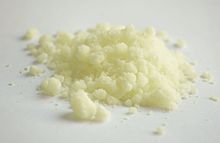| Revision as of 18:51, 16 January 2024 edit1.46.141.116 (talk) →top: CßNG TY C. PH.N STAR NESTTags: Reverted references removed Mobile edit Mobile app edit Android app edit← Previous edit | Revision as of 18:54, 16 January 2024 edit undoLizardJr8 (talk | contribs)Extended confirmed users, Pending changes reviewers, Rollbackers97,740 editsm Reverted 1 edit by 1.46.141.116 (talk) to last revision by Michael7604Tags: Twinkle UndoNext edit → | ||
| Line 1: | Line 1: | ||
| {{Redirect|DNCB|the Bucharest Ring Road in Romania|Centura București}} | |||
| ⚫ | {{Chembox Identifiers | ||
| {{Chembox | |||
| | Verifiedfields = changed | |||
| | Watchedfields = changed | |||
| | verifiedrevid = 477211218 | |||
| | ImageFile=2,4-Dinitrochlorobenzene.svg | |||
| | ImageSize=130px | |||
| | ImageFile1 = 1-chloro-2,4-dinitrobenzene.JPG | |||
| | PIN = 1-Chloro-2,4-dinitrobenzene | |||
| | OtherNames = Dinitrochlorobenzene<br />Chlorodinitrobenzene<br />2,4-Dinitrochlorobenzene<br />2,4-Dinitrophenyl chloride<br />4-Chloro-1,3-dinitrobenzene | |||
| ⚫ | |Section1={{Chembox Identifiers | ||
| | Abbreviations = CDNB; DNCB | | Abbreviations = CDNB; DNCB | ||
| | CASNo_Ref = {{cascite|correct|CAS}} | | CASNo_Ref = {{cascite|correct|CAS}} | ||
| Line 11: | Line 21: | ||
| | ChEBI_Ref = {{ebicite|changed|EBI}} | | ChEBI_Ref = {{ebicite|changed|EBI}} | ||
| | ChEBI = 34718 | | ChEBI = 34718 | ||
| | SMILES = c1cc(c(cc1(=O))(=O))Cl | |||
| | < | |||
| | InChI = 1S/C6H3ClN2O4/c7-5-2-1-4(8(10)11)3-6(5)9(12)13/h1-3H | |||
| | InChIKey = VYZAHLCBVHPDDF-UHFFFAOYSA-N | |||
| }} | |||
| |Section2={{Chembox Properties | |||
| | C=6 | H=3 | Cl=1 | N=2 | O=4 | |||
| | Formula = | |||
| | MolarMass = | |||
| | Appearance = yellow crystals | |||
| | Odor = almond-like | |||
| | Density = 1.6867 g/cm<sup>3</sup> | |||
| | MeltingPtC = 54 | |||
| | BoilingPtC = 315 | |||
| | Solubility = Insoluble<ref>{{cite web|title=1-Chloro-2,4-dinitrobenzene|url=http://www.sigmaaldrich.com/catalog/product/aldrich/138630?lang=en®ion=US|website=Sigma-Aldrich|access-date=8 September 2014}}</ref> | |||
| | SolubleOther = soluble in ], ], ] | |||
| | RefractIndex = 1.5857 (60 °C) | |||
| }} | |||
| |Section4={{Chembox Hazards | |||
| | MainHazards = | |||
| | FlashPt = | |||
| | AutoignitionPt = | |||
| | ExploLimits = 2–22% | |||
| | NFPA-H = 3 | NFPA-F = 1 | NFPA-R = 4 | |||
| | LD50 = 1.07 g/kg (rat, oral) | |||
| }} | }} | ||
| }} | }} | ||
Revision as of 18:54, 16 January 2024
"DNCB" redirects here. For the Bucharest Ring Road in Romania, see Centura București.
| |

| |
| Names | |
|---|---|
| Preferred IUPAC name 1-Chloro-2,4-dinitrobenzene | |
| Other names
Dinitrochlorobenzene Chlorodinitrobenzene 2,4-Dinitrochlorobenzene 2,4-Dinitrophenyl chloride 4-Chloro-1,3-dinitrobenzene | |
| Identifiers | |
| CAS Number | |
| 3D model (JSmol) | |
| Abbreviations | CDNB; DNCB |
| ChEBI | |
| ChemSpider | |
| ECHA InfoCard | 100.002.321 |
| EC Number |
|
| PubChem CID | |
| UNII | |
| CompTox Dashboard (EPA) | |
InChI
| |
SMILES
| |
| Properties | |
| Chemical formula | C6H3ClN2O4 |
| Molar mass | 202.55 g·mol |
| Appearance | yellow crystals |
| Odor | almond-like |
| Density | 1.6867 g/cm |
| Melting point | 54 °C (129 °F; 327 K) |
| Boiling point | 315 °C (599 °F; 588 K) |
| Solubility in water | Insoluble |
| Solubility | soluble in ether, benzene, CS2 |
| Refractive index (nD) | 1.5857 (60 °C) |
| Hazards | |
| NFPA 704 (fire diamond) |
 |
| Explosive limits | 2–22% |
| Lethal dose or concentration (LD, LC): | |
| LD50 (median dose) | 1.07 g/kg (rat, oral) |
| Except where otherwise noted, data are given for materials in their standard state (at 25 °C , 100 kPa).
| |
2,4-Dinitrochlorobenzene (DNCB) is an organic compound with the chemical formula (O2N)2C6H3Cl. It is a yellow solid that is soluble in organic solvents. It is an important intermediate for the industrial production of other compounds.
DNCB is produced commercially by the nitration of p-nitrochlorobenzene with a mixture of nitric and sulfuric acids. Other methods afford the compound less efficiently include the chlorination of dinitrobenzene, nitration of o-nitrochlorobenzene and the dinitration of chlorobenzene.
Uses
By virtue of the two nitro groups, the chloride is susceptible to nucleophilic substitution. In this way, the compound is a precursor to many other compounds.
Laboratory use
DNCB is used as a substrate in GST enzyme activity assays. The molecule is conjugated to a single molecule of reduced glutathione which then absorbs at 340 nm. Affinity of CDNB for each class of GST varies and so it is not a good measure of activity for some forms (e.g. GSTT and GSTZ).
Medical use
DNCB can be used to treat warts with an effective cure rate of 80%. DNCB induces an allergic immune response toward the wart-causing virus.
Safety
DNCB induces a type IV hypersensitivity reaction in almost all people exposed to it, so it is used medically to assess the T cell activity in patients. This is a useful diagnostic test for immunocompromised patients. It can also be used to treat warts.
DNCB can cause contact dermatitis.
References
- "1-Chloro-2,4-dinitrobenzene". Sigma-Aldrich. Retrieved 8 September 2014.
- Gerald Booth (2007). "Nitro Compounds, Aromatic". Ullmann's Encyclopedia of Industrial Chemistry. Weinheim: Wiley-VCH. doi:10.1002/14356007.a17_411. ISBN 978-3527306732.
- "Synthesis of 1-chloro-2,4-dinitrobenzene - F. Ullmann, Verlag S. Hirzel Leipzig, 1908" (PDF). Retrieved 19 May 2020.
- J. F. Bunnett, R. M. Conner (1960). "2,4-Dinitroiodobenzene". Organic Syntheses. 40: 34. doi:10.15227/orgsyn.040.0034.
- F. B. Wells, C. F. H. Allen (1935). "2,4-Dinitroaniline". Organic Syntheses. 15: 22. doi:10.15227/orgsyn.015.0022.
- Norman Kharasch, Robert B. Langford (1964). "2,4-Dinitrobenzenesulfenyl Chloride". Organic Syntheses. 44: 47. doi:10.15227/orgsyn.044.0047.
- Habig WH, Pabst MJ, Jakoby WB (1974). "Glutathione S-transferases. The first enzymatic step in mercapturic acid formation". J Biol Chem. 249 (22): 7130–7139. doi:10.1016/S0021-9258(19)42083-8. PMID 4436300.
- ^ "Treating Warts". Harvard Health Publications. Harvard Medical School. 21 September 2011.
- "Treating warts". Harvard Medical School. Archived from the original on 2010-11-03. Retrieved April 2, 2010.
- White SI, Friedmann PS, Moss C, Simpson JM (1986). "The effect of altering area of application and dose per unit area on sensitization by DNCB". Br. J. Dermatol. 115 (6): 663–8. doi:10.1111/j.1365-2133.1986.tb06646.x. PMID 3801307. S2CID 21476276.